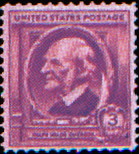Asa Whitney
 But two decades before the Civil War, the nation was still in a pioneer spirit.
The depression of 1837 was past and the panic was over. "Ours is a country of
beginnings, of projects, of vast designs and expectations",
Emerson wrote. "It has no past: all has an
onward and prospective look.[18]"
Symbolic of the economic growth of the years to come, was the vision of Asa Whitney.
This China merchant of New York looked over the western plains and the Rocky
Mountains to the Pacific, where he saw a railroad joining that ocean with the
Atlantic[19].
But two decades before the Civil War, the nation was still in a pioneer spirit.
The depression of 1837 was past and the panic was over. "Ours is a country of
beginnings, of projects, of vast designs and expectations",
Emerson wrote. "It has no past: all has an
onward and prospective look.[18]"
Symbolic of the economic growth of the years to come, was the vision of Asa Whitney.
This China merchant of New York looked over the western plains and the Rocky
Mountains to the Pacific, where he saw a railroad joining that ocean with the
Atlantic[19].
As early as 1845, even before the Mexican War, the Oregon Treaty, and the discovery of gold in California, Whitney addressed the US Congress, recommending that a survey for a transcontinental railroad between the 42nd and 45th parallels be organized as soon as possible. He then went on a tour of the country, making speeches, visiting community leaders, and writing letters to newspapers to try and arouse support for the railroad. In the summer of that year he organized an expedition at his own expense to explore a rail route towards the Western Sea. Starting at Milwaukee, he and his group of young adventurers crossed the prairies to the Great Bend of the Missouri. Every so often Whitney sent back long reports to newspapers, praising the richness of the country through which his railroad would pass and urging the government to complete his survey from the Missouri to the Pacific Coast. After returning to the East, Whitney again asked Congress to act. He presented them with specific geographical details for a transcontinental route, and offered to build the railroad himself in exchange for a land grant sixty miles wide from Lake Michigan to the Pacific. Whitney said he could raise sufficient funds to pay expenses for construction by selling off this land as the road was being built. He calculated that the bulk of the work could be accomplished within fifteen years, and that "the over-population of Europe must and will flock to it".
His principal obstacle was the presence of the Indians, since their land titles were still legitimate. But Whitney assured Congress that the Native Americans were "ready and willing to sell all that may be desirable for this object, and for a very small sum. . . and this road would produce a revolution in the situation of the red as well as the white man. The Sioux Indians occupy and claim nearly all the lands from above latitude of about 43 degrees from the Mississippi to the Rocky Mountains. They are numerous, powerful, and entirely savage". Whitney shrewdly indicated that the building of the railroad would drive the "savage" Sioux and their buffalo northward: "and we can then succeed in bringing the removed and small tribes to habits of industry and civilization, and their race may be preserved until mixed and blended with ours, and the Sioux must soon follow them". In Whitney's eyes, a transcontinental railroad was an indispensable part of the nation's destiny. "Now only is the time in which it can be done … someone's whole efforts, energies, and life must be devoted to it.[20]" Asa Whitney would be honored to be that someone.
By this time the South had become suspicious of Whitney. That region's commercial interests wanted no part of a transcontinental railroad beginning on the shore of Lake Michigan, and their political representatives in Washington began a storm of publicity against "the railroad schemes of Asa Whitney". Soon, an imposing number of opponents began offering rival proposals. Stephen A. Douglas, an ambitious politician, represented the Chicago viewpoint and supported a route to Council Bluffs that would later be followed by the Chicago & Rock Island Railroad. The arguments offered against Whitney's route were that it was too far to the north; the climate was harsh; there was no fuel for locomotives; the Indians were hostile, and the land would most likely never be inhabited by white settlers. One opposition group called it a scheme of gigantic robbery.
During the lively debates over all these various routes, no one ever mentioned the Native Americans; the Indians who had lived for centuries on the lands which the Iron Horse would invade. The Indians were ignored as completely as if they held no more rights to the land than the buffalo or antelope. Only Asa Whitney remembered them, and his main concern was to nullify their land titles and then either force them to become like white men or drive them out of the way.
Late in 1848, two significant railroad conventions were held in St. Louis and Memphis. Hundreds of representatives from all over the United States were present, but all they could agree upon was that the U.S. Army should make an extensive series of surveys to determine the best route for a railroad. Asa Whitney made one last desperate attempt to secure financial backing and traveled to England in 1851, but found no support. After years of effort, he abandoned his dream of the Iron Horse and the Western Sea and retired to his dairy farm near Washington. He did, however, live to see his dream accomplished.
